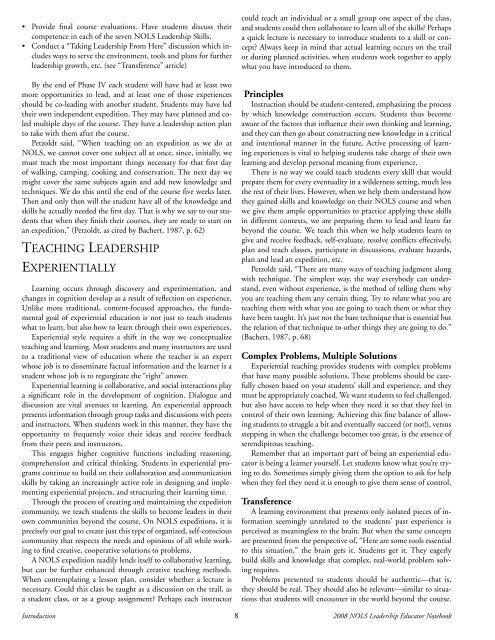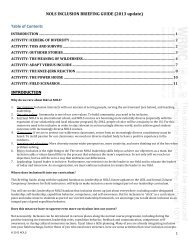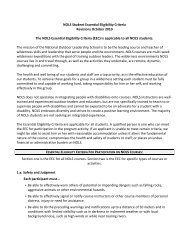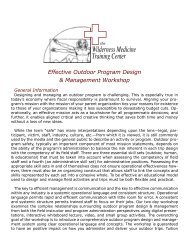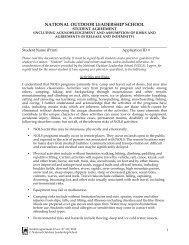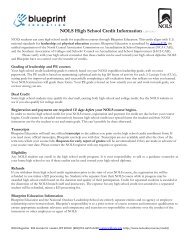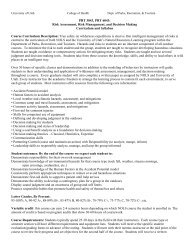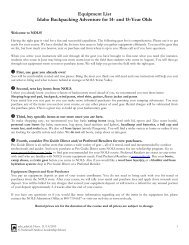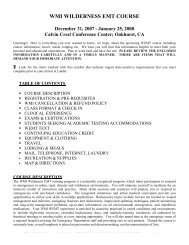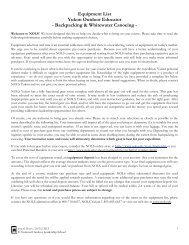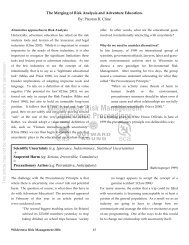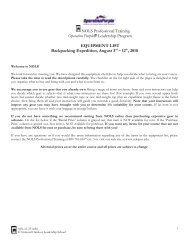introduction to the 2008 nols leadership educator notebook
introduction to the 2008 nols leadership educator notebook
introduction to the 2008 nols leadership educator notebook
Create successful ePaper yourself
Turn your PDF publications into a flip-book with our unique Google optimized e-Paper software.
• Provide final course evaluations. Have students discuss <strong>the</strong>ircompetence in each of <strong>the</strong> seven NOLS Leadership Skills.• Conduct a “Taking Leadership From Here” discussion which includesways <strong>to</strong> serve <strong>the</strong> environment, <strong>to</strong>ols and plans for fur<strong>the</strong>r<strong>leadership</strong> growth, etc. (see “Transference” article)By <strong>the</strong> end of Phase IV each student will have had at least twomore opportunities <strong>to</strong> lead, and at least one of those experiencesshould be co-leading with ano<strong>the</strong>r student. Students may have led<strong>the</strong>ir own independent expedition. They may have planned and coledmultiple days of <strong>the</strong> course. They have a <strong>leadership</strong> action plan<strong>to</strong> take with <strong>the</strong>m after <strong>the</strong> course.Petzoldt said, “When teaching on an expedition as we do atNOLS, we cannot cover one subject all at once, since, initially, wemust teach <strong>the</strong> most important things necessary for that first dayof walking, camping, cooking and conservation. The next day wemight cover <strong>the</strong> same subjects again and add new knowledge andtechniques. We do this until <strong>the</strong> end of <strong>the</strong> course five weeks later.Then and only <strong>the</strong>n will <strong>the</strong> student have all of <strong>the</strong> knowledge andskills he actually needed <strong>the</strong> first day. That is why we say <strong>to</strong> our studentsthat when <strong>the</strong>y finish <strong>the</strong>ir courses, <strong>the</strong>y are ready <strong>to</strong> start onan expedition.” (Petzoldt, as cited by Bachert, 1987, p. 62)TEACHING LEADERSHIPEXPERIENTIALLYLearning occurs through discovery and experimentation, andchanges in cognition develop as a result of reflection on experience.Unlike more traditional, content-focused approaches, <strong>the</strong> fundamentalgoal of experiential education is not just <strong>to</strong> teach studentswhat <strong>to</strong> learn, but also how <strong>to</strong> learn through <strong>the</strong>ir own experiences.Experiential style requires a shift in <strong>the</strong> way we conceptualizeteaching and learning. Most students and many instruc<strong>to</strong>rs are used<strong>to</strong> a traditional view of education where <strong>the</strong> teacher is an expertwhose job is <strong>to</strong> disseminate factual information and <strong>the</strong> learner is astudent whose job is <strong>to</strong> regurgitate <strong>the</strong> “right” answer.Experiential learning is collaborative, and social interactions playa significant role in <strong>the</strong> development of cognition. Dialogue anddiscussion are vital avenues <strong>to</strong> learning. An experiential approachpresents information through group tasks and discussions with peersand instruc<strong>to</strong>rs. When students work in this manner, <strong>the</strong>y have <strong>the</strong>opportunity <strong>to</strong> frequently voice <strong>the</strong>ir ideas and receive feedbackfrom <strong>the</strong>ir peers and instruc<strong>to</strong>rs.This engages higher cognitive functions including reasoning,comprehension and critical thinking. Students in experiential programscontinue <strong>to</strong> build on <strong>the</strong>ir collaboration and communicationskills by taking an increasingly active role in designing and implementingexperiential projects, and structuring <strong>the</strong>ir learning time.Through <strong>the</strong> process of creating and maintaining <strong>the</strong> expeditioncommunity, we teach students <strong>the</strong> skills <strong>to</strong> become leaders in <strong>the</strong>irown communities beyond <strong>the</strong> course. On NOLS expeditions, it isprecisely our goal <strong>to</strong> create just this type of organized, self-consciouscommunity that respects <strong>the</strong> needs and opinions of all while working<strong>to</strong> find creative, cooperative solutions <strong>to</strong> problems.A NOLS expedition readily lends itself <strong>to</strong> collaborative learning,but can be fur<strong>the</strong>r enhanced through creative teaching methods.When contemplating a lesson plan, consider whe<strong>the</strong>r a lecture isnecessary. Could this class be taught as a discussion on <strong>the</strong> trail, asa student class, or as a group assignment? Perhaps each instruc<strong>to</strong>rIntroduction 8could teach an individual or a small group one aspect of <strong>the</strong> class,and students could <strong>the</strong>n collaborate <strong>to</strong> learn all of <strong>the</strong> skills? Perhapsa quick lecture is necessary <strong>to</strong> introduce students <strong>to</strong> a skill or concept?Always keep in mind that actual learning occurs on <strong>the</strong> trailor during planned activities, when students work <strong>to</strong>ge<strong>the</strong>r <strong>to</strong> applywhat you have introduced <strong>to</strong> <strong>the</strong>m.PrinciplesInstruction should be student-centered, emphasizing <strong>the</strong> processby which knowledge construction occurs. Students thus becomeaware of <strong>the</strong> fac<strong>to</strong>rs that influence <strong>the</strong>ir own thinking and learning,and <strong>the</strong>y can <strong>the</strong>n go about constructing new knowledge in a criticaland intentional manner in <strong>the</strong> future. Active processing of learningexperiences is vital <strong>to</strong> helping students take charge of <strong>the</strong>ir ownlearning and develop personal meaning from experience.There is no way we could teach students every skill that wouldprepare <strong>the</strong>m for every eventuality in a wilderness setting, much less<strong>the</strong> rest of <strong>the</strong>ir lives. However, when we help <strong>the</strong>m understand how<strong>the</strong>y gained skills and knowledge on <strong>the</strong>ir NOLS course and whenwe give <strong>the</strong>m ample opportunities <strong>to</strong> practice applying <strong>the</strong>se skillsin different contexts, we are preparing <strong>the</strong>m <strong>to</strong> lead and learn farbeyond <strong>the</strong> course. We teach this when we help students learn <strong>to</strong>give and receive feedback, self-evaluate, resolve conflicts effectively,plan and teach classes, participate in discussions, evaluate hazards,plan and lead an expedition, etc.Petzoldt said, “There are many ways of teaching judgment alongwith technique. The simplest way, <strong>the</strong> way everybody can understand,even without experience, is <strong>the</strong> method of telling <strong>the</strong>m whyyou are teaching <strong>the</strong>m any certain thing. Try <strong>to</strong> relate what you areteaching <strong>the</strong>m with what you are going <strong>to</strong> teach <strong>the</strong>m or what <strong>the</strong>yhave been taught. It’s just not <strong>the</strong> bare technique that is essential but<strong>the</strong> relation of that technique <strong>to</strong> o<strong>the</strong>r things <strong>the</strong>y are going <strong>to</strong> do.”(Bachert, 1987, p. 68)Complex Problems, Multiple SolutionsExperiential teaching provides students with complex problemsthat have many possible solutions. These problems should be carefullychosen based on your students’ skill and experience, and <strong>the</strong>ymust be appropriately coached. We want students <strong>to</strong> feel challenged,but also have access <strong>to</strong> help when <strong>the</strong>y need it so that <strong>the</strong>y feel incontrol of <strong>the</strong>ir own learning. Achieving this fine balance of allowingstudents <strong>to</strong> struggle a bit and eventually succeed (or not!), versusstepping in when <strong>the</strong> challenge becomes <strong>to</strong>o great, is <strong>the</strong> essence ofserendipi<strong>to</strong>us teaching.Remember that an important part of being an experiential educa<strong>to</strong>ris being a learner yourself. Let students know what you’re trying<strong>to</strong> do. Sometimes simply giving <strong>the</strong>m <strong>the</strong> option <strong>to</strong> ask for helpwhen <strong>the</strong>y feel <strong>the</strong>y need it is enough <strong>to</strong> give <strong>the</strong>m sense of control.TransferenceA learning environment that presents only isolated pieces of informationseemingly unrelated <strong>to</strong> <strong>the</strong> students’ past experience isperceived as meaningless <strong>to</strong> <strong>the</strong> brain. But when <strong>the</strong> same conceptsare presented from <strong>the</strong> perspective of, “Here are some <strong>to</strong>ols essential<strong>to</strong> this situation,” <strong>the</strong> brain gets it. Students get it. They eagerlybuild skills and knowledge that complex, real-world problem solvingrequires.Problems presented <strong>to</strong> students should be au<strong>the</strong>ntic—that is,<strong>the</strong>y should be real. They should also be relevant—similar <strong>to</strong> situationsthat students will encounter in <strong>the</strong> world beyond <strong>the</strong> course.<strong>2008</strong> NOLS Leadership Educa<strong>to</strong>r Notebook


